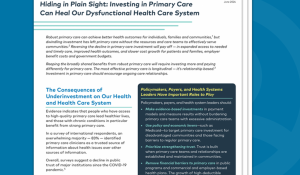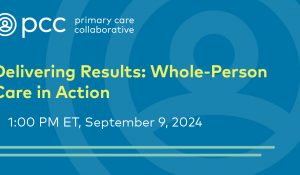The Quick Start Guide provides clinicians and practice staff with five simple steps for implementing the warm handoff strategy in the office setting, and resources to encourage patient participation.
You are looking at an archived version of our site. Please visit thepcc.org for a fresh, new experience!
Collaborative Partnerships
Related Resources
October 2014
Transformational improvement in our healthcare system needs to be informed by the voice of the customer. Learn from national expert Christine Bechtel about the value of engaging patients and families in this quick 5-minute video.
Qualis Health
September 2019
Patient portals are becoming more prevalent, as healthcare providers, payers, and patients become more comfortable with their use. A 2017 survey found that 82% of patients reported having logged into their provider’s patient portal at least once – a drastic change from a similar 2013...
Patient Portals: How can they impact primary care?
October 2018
This peer-reviewed report on health care transition for pediatric to adult health care includes a process for transition preparation, planning, tracking, and follow-through and is based on more than two decades of evidence-based research. A special focus is placed on young adults with special...
American Academy of Pediatrics
September 2018
The toolkit contains educational materials and training templates for effectively engaging patient advisors in research projects. Materials can be tailored for each research project.
Health Innovation Program, University of Wisconsin, Wisconsin Network for Research Support
April 2018
This document outlines how patient and family engagement activities can improve health outcomes and achieve TCPI program-specific metrics, which align with quality payment program standards. Links to additional resources for a deeper dive are also provided.
Northern New England Practice Transformation Network
April 2018
This comprehensive guide provides primary care practices with four strategies that they can adopt to improve patient safety and engagement.
AHRQ
April 2018
Five modules and links to a wide-range of resources for moving patients forward on the patient activation continuum. The tools are listed by category, and include Activation, Communication, Decision Aids, Self-Management and Shared-Decision Making.
Military Heath System
March 2018
AHRQ’s SHARE Approach is a five-step process for shared decision-making. Fact sheets, learning modules, videos, success stories, webinars and marketing materials are available.
AHRQ
March 2018
This learning module reviews common causes of medication nonadherence and how your practice can establish a standrd process to address them. 0.5 CME credits from the AMA are available upon completion.
American Medical Association, AMA Steps Forward
March 2018
The Quick Start Guide provides clinicians and practice staff with five simple steps for implementing the teach-back approach in the office setting.
AHRQ
February 2018
Learning module highlighting steps for developing and implementing health coaching models within practices offered by American Medical Association STEPS Forward. Participants can earn 0.5 CME Credits.
American Medical Association, AMA Steps Forward
October 2017
This document guides the creation of a six-step action plan for collaboration with patients and families in primary care practices or Practice Transformation Networks (PTN).
PCPCC
September 2017
Five recorded learning network calls lead by a pediatric quality improvement expert showcasing pediatric practices that have improved asthma care quality, and links to supplemental resources (some in Spanish).
PCPCC
June 2017
About this Guide:
When patients and families build partnerships with their health care team – such as doctors, nurse practitioners, nurses and clinic staff - to improve health care, everyone benefits! This guide will help you decide if you want to partner with your health care team as...
PCPCC
May 2017
This document provides practical tools, resources, and strategies to test different patient and family engagement approaches and determine the best fit for your primary care practice.
American Academy of Pediatrics, National Resource Center for Patient/Family-Centered Medical Home
November 2016
In November 2016, PCPCC offered a special one-day training for patient advisors, family caregivers and their clinician partners. This page contains presentation slides from the sessions, and highlight tools and strategies for implementing patient and family engagement strategies.
PCPCC
June 2016
Below are resources from seminars and trainings, for PAC staff, leaders, and patient advisors at San Francisco Health Network Primary Care. Find more additional information here!
San Francisco Department of Public Health
June 2016
This document can be used for self-reflection across a number of important principles of leadership and patient-centered care.
Planetree
May 2016
Turn-key implementation guide and presentation slides to start a patient and family advisory council.
Bon Secours Virginia Health System
Pagine
Secondary menu
Copyright © 2024 Primary Care Collaborative












